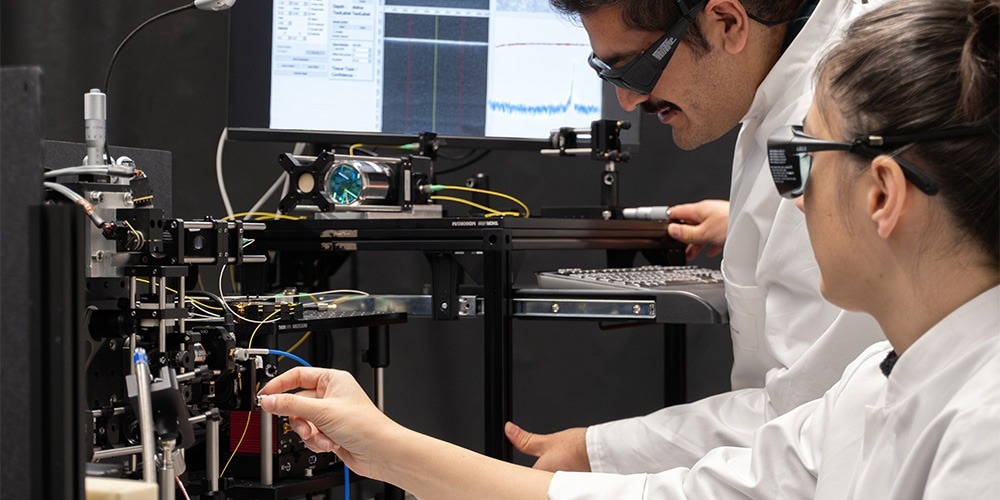Opting for lasers over traditional scalpels and saws presents numerous advantages in surgery. However, their utilization remains limited to isolated cases.
 Dr. Arsham Hamidi and Dr Ferda Canbaz at the laser lab. Image Credit: Universität Basel, Reinhard Wendler.
Dr. Arsham Hamidi and Dr Ferda Canbaz at the laser lab. Image Credit: Universität Basel, Reinhard Wendler.
However, this scenario might be on the verge of transformation, thanks to the continuous improvement of laser systems showcased by a research team from the University of Basel.
Even as early as 1957, when Gordon Gould coined the term “laser” (Light Amplification by Stimulated Emission of Radiation), he envisioned its potential applications in medicine, where surgeons could achieve precision in incisions without direct contact with the patient.
Before such possibilities could materialize, numerous obstacles had to be addressed, and many persist today.
The transition from manually controlled light sources to mechanical and computer-controlled systems aimed to reduce injuries resulting from clumsy handling. The shift from continuous beams to pulsed lasers, rapidly alternating between on and off states, helped mitigate the heat they generate.
In the early 1990s, technical advancements facilitated the integration of lasers into ophthalmology. Although progress has been made in various medical fields, replacing traditional scalpels and bone saws with lasers remains limited to specific applications.
The primary challenge revolves around safety concerns: How can we prevent harm to surrounding tissues? What level of control can be exerted over cutting depth to avoid inadvertent damage to deeper layers of tissue?
The University of Basel researchers have significantly advanced the safe and accurate application of lasers, as detailed in their recent publication in the specialized journal Lasers in Surgery and Medicine.
Headed by Dr. Ferda Canbaz from the Department of Biomedical Engineering in Basel and Professor Azhar Zam, formerly affiliated with the University of Basel and currently based at New York University, the research team has innovatively devised a system that integrates three key functions: bone-cutting, precise control of cutting depth, and differentiation between various tissues.
Three Lasers Directed at One Spot
The trio of functions is executed by three precisely aligned lasers converging on a common focal point. The initial laser functions as a tissue sensor, scanning the vicinity where bone cutting is intended.
Regular pulses emitted by this laser effectively vaporize minuscule tissue portions, and a spectrometer measures the composition of the resulting vaporized tissue sample. Each tissue type possesses a distinct spectrum akin to its unique signature. An algorithm processes this data, generating a map delineating the locations of bones and soft tissue.
Only after this mapping process is concluded does the second laser, responsible for bone cutting, activate. It operates exclusively in areas identified on the generated map as containing bones rather than soft tissue.
Simultaneously, the third laser, functioning as an optical system, gauges the cut's depth and ensures the cutting laser adheres to the planned depth. Throughout the cutting phase, the tissue sensor continually monitors the accuracy of the tissue being cut.
Autonomous Control
The special thing about our system is that it controls itself – without human interference.
Ferda Canbaz, Laser Physicist, University of Basel
The researchers have conducted initial tests of their system using femur bones and tissue from pigs sourced from a local butcher. Their experiments demonstrated the system's precise functionality down to fractions of a millimeter. Moreover, the combined laser's speed approaches that of conventional surgical procedures.
Presently, the research team is focused on reducing the system’s size. They have successfully minimized it to the dimensions of a matchbox by combining the optical system and the cutting laser alone (refer to the original publication here).
Their ongoing efforts involve incorporating the tissue sensor and further downsizing the entire system. Once achieved, they anticipate fitting it into the tip of an endoscope, enabling the execution of minimally invasive procedures.
Less Invasive Surgery
Making more use of lasers in surgery is a worthy ambition for a number of reasons. Smaller and more precise incisions also mean that the tissue heals more rapidly, and that scarring is reduced.
Dr. Arsham Hamidi, Study Lead Author, University of Basel
Hamidi’s contact-free cutting method helps mitigate the risk of infections.
Laser-based controlled cutting introduces the possibility of employing novel cutting shapes. This enables, for example, the physical interlocking of a bone implant with the existing bone.
One day we might be able to do without bone cement completely.
Ferda Canbaz, Laser Physicist, University of Basel
In various surgical domains, this integrated configuration could prove valuable. It has the potential to enhance the precise differentiation of tumors from adjacent healthy tissue, facilitating their removal without unnecessary damage to neighboring tissues.
One certainty emerges: Gordon Gould’s vision of the laser as a versatile medical tool is steadily approaching realization.
Journal Reference:
Hamidi, A., et al. (2023) Multimodal feedback systems for smart laser osteotomy: Depth control and tissue differentiation. Lasers in Surgery and Medicine. doi.org/10.1002/lsm.23732.